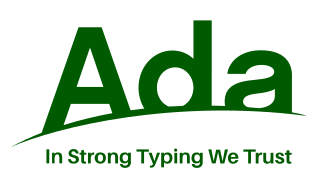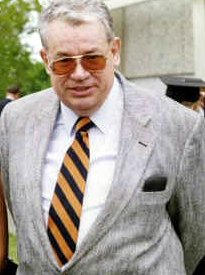Related Research Articles

Ada is a structured, statically typed, imperative, and object-oriented high-level programming language, inspired by Pascal and other languages. It has built-in language support for design by contract (DbC), extremely strong typing, explicit concurrency, tasks, synchronous message passing, protected objects, and non-determinism. Ada improves code safety and maintainability by using the compiler to find errors in favor of runtime errors. Ada is an international technical standard, jointly defined by the International Organization for Standardization (ISO), and the International Electrotechnical Commission (IEC). As of May 2023, the standard, called Ada 2022 informally, is ISO/IEC 8652:2023.
The editor war is the rivalry between users of the Emacs and vi text editors. The rivalry has become an enduring part of hacker culture and the free software community.

A hacker is a person skilled in information technology who achieves goals by non-standard means. The term has become associated in popular culture with a security hacker – someone with knowledge of bugs or exploits to break into computer systems and access data which would otherwise be inaccessible to them. In a positive connotation, though, hacking can also be utilized by legitimate figures in legal situations. For example, law enforcement agencies sometimes use hacking techniques to collect evidence on criminals and other malicious actors. This could include using anonymity tools to mask their identities online and pose as criminals.

Niklaus Emil Wirth was a Swiss computer scientist. He designed several programming languages, including Pascal, and pioneered several classic topics in software engineering. In 1984, he won the Turing Award, generally recognized as the highest distinction in computer science, "for developing a sequence of innovative computer languages".
Pascal is an imperative and procedural programming language, designed by Niklaus Wirth as a small, efficient language intended to encourage good programming practices using structured programming and data structuring. It is named after French mathematician, philosopher and physicist Blaise Pascal.
Software engineering is an engineering approach to software development. A practitioner, called a software engineer, applies the engineering design process to develop software.
Spaghetti code is a pejorative phrase for difficult-to-maintain and unstructured computer source code. Code being developed with poor structure can be due to any of several factors, such as volatile project requirements, lack of programming style rules, and software engineers with insufficient ability or experience.
TECO, short for Text Editor & Corrector, is both a character-oriented text editor and a programming language, that was developed in 1962 for use on Digital Equipment Corporation computers, and has since become available on PCs and Unix. Dan Murphy developed TECO while a student at the Massachusetts Institute of Technology (MIT).
In computing, WYSIWYG, an acronym for what you see is what you get, refers to software that allows content to be edited in a form that resembles its appearance when printed or displayed as a finished product, such as a printed document, web page, or slide presentation. WYSIWYG implies a user interface that allows the user to view something very similar to the result while the document is being created. In general, WYSIWYG implies the ability to directly manipulate the layout of a document without having to type or remember names of layout commands.
Turbo Pascal is a software development system that includes a compiler and an integrated development environment (IDE) for the programming language Pascal running on the operating systems CP/M, CP/M-86, and DOS. It was originally developed by Anders Hejlsberg at Borland, and was notable for its very fast compiling. Turbo Pascal, and the later but similar Turbo C, made Borland a leader in PC-based development tools.
The hacker culture is a subculture of individuals who enjoy—often in collective effort—the intellectual challenge of creatively overcoming the limitations of software systems or electronic hardware, to achieve novel and clever outcomes. The act of engaging in activities in a spirit of playfulness and exploration is termed hacking. However, the defining characteristic of a hacker is not the activities performed themselves, but how it is done and whether it is exciting and meaningful. Activities of playful cleverness can be said to have "hack value" and therefore the term "hacks" came about, with early examples including pranks at MIT done by students to demonstrate their technical aptitude and cleverness. The hacker culture originally emerged in academia in the 1960s around the Massachusetts Institute of Technology (MIT)'s Tech Model Railroad Club (TMRC) and MIT Artificial Intelligence Laboratory. Hacking originally involved entering restricted areas in a clever way without causing any major damage. Some famous hacks at the Massachusetts Institute of Technology were placing of a campus police cruiser on the roof of the Great Dome and converting the Great Dome into R2-D2.

Fernando José "Corby" Corbató was an American computer scientist, notable as a pioneer in the development of time-sharing operating systems.

Datamation is a computer magazine that was published in print form in the United States between 1957 and 1998, and has since continued publication on the web. Datamation was previously owned by QuinStreet and acquired by TechnologyAdvice in 2020. Datamation is published as an online magazine at Datamation.com.

Per Brinch Hansen was a Danish-American computer scientist known for his work in operating systems, concurrent programming and parallel and distributed computing.
The Story of Mel is an archetypical piece of computer programming folklore. Its subject, Melvin Kaye, is an exemplary "Real Programmer" whose subtle techniques fascinate his colleagues.
Melvin Edward Conway is an American computer scientist, computer programmer, and hacker who coined what is now known as Conway's law: "Organizations, who design systems, are constrained to produce designs which are copies of the communication structures of these organizations." The adage remains relevant in modern software engineering and is still being referenced and investigated.

Chapel, the Cascade High Productivity Language, is a parallel programming language that was developed by Cray, and later by Hewlett Packard Enterprise which acquired Cray. It was being developed as part of the Cray Cascade project, a participant in DARPA's High Productivity Computing Systems (HPCS) program, which had the goal of increasing supercomputer productivity by 2010. It is being developed as an open source project, under version 2 of the Apache license.
In engineering, debugging is the process of finding the root cause of and workarounds and possible fixes for bugs.

Margaret Elaine Hamilton is an American computer scientist. She was director of the Software Engineering Division of the MIT Instrumentation Laboratory, which developed on-board flight software for NASA's Apollo program. She later founded two software companies—Higher Order Software in 1976 and Hamilton Technologies in 1986, both in Cambridge, Massachusetts.
CP-6 is a discontinued computer operating system, developed by Honeywell, Inc. in 1976, which was a backward-compatible work-alike of the Xerox CP-V, fully rewritten for Honeywell Level/66 hardware. CP-6 was a command line oriented system. A terminal emulator allowed use of PCs as CP-6 terminals.
References
- ↑ Post, Ed (July 1983). "Real Programmers Don't Use Pascal". Archived from the original on 2012-02-06.
- ↑ Note: Graphic Software Systems was a 1981 spin-off of Tektronix
- ↑ Datamation. Vol. 29. United States: Technical Publishing. July 1983. pp. 263–265.
- 1 2 Eric S. Raymond, ed. (July 27, 1993). "Real Programmer". The New Hacker's Dictionary. Retrieved 2008-03-28.
- ↑ Ian Gorton (November 1995). "Real Programmers Do Use Delphi". IEEE Software. 12 (6). IEEE Computer Society: 8–12. doi:10.1109/52.469755 . Retrieved 2008-03-28.
- ↑ Erik Brunvand (October 15, 1996). "The Heroic Hacker: Legends of the Computer Age" (PostScript). p. 4. Retrieved 2008-03-28.
- ↑ "More About Real Programmers". Archived from the original on 2008-04-19. Retrieved 2008-03-28.
- ↑ REAL programmers xkcd.com